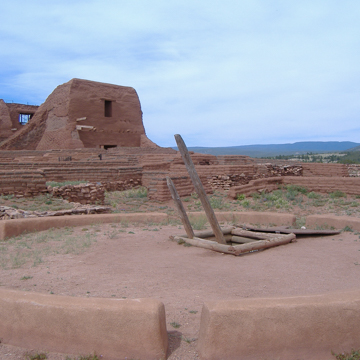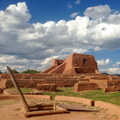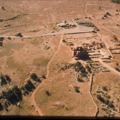When Franciscan missionaries arrived in New Mexico with a goal of converting the Indigenous population, they envisioned a “City of God on the Rio Grande,” a place where an ideal Christian society could be realized. Once the friars established their headquarters in Santa Fe, they knew that one city alone could not accomplish this mission since the Indigenous settlements were numerous and scattered throughout the region. The Spanish established the mission system, a network of religious spaces meant to spread Christianity upon the Indigenous peoples, a diverse group whom the Spanish called Puebloans. Pecos exemplifies both the mission system and its architecture as well as the Puebloan ability to make use of missions for their own interests.
These religious spaces shared the same hierarchy as the urban centers of New Mexico. The head or parroquia was in the capital city of Santa Fe, at the Church of San Francisco. At the next level was a series of missions, like the one at Pecos, which were established in larger towns. Although these missions were autonomous, and expected to be self-supporting, they still had to follow any decrees that came from the parroquia at Santa Fe. The friars who established these missions lived in and became active members of the community, teaching Puebloans the Spanish language, culture, and religion. They also worked alongside local leadership to administer resources and implement policies that came from Santa Fe. At the lowest level were visitas, small-scale chapels built in smaller communities; the friars visited these communities only occasionally to administer the sacraments. In the eyes of the Spaniards, this mission system facilitated the conversion of Native peoples to Christianity by decentralizing evangelization efforts, as the dispersed and autonomous missions and visitas could reach a large number of Puebloans but still have coordinating leadership coming from the parroquia.
The Spanish friars decided to establish a church at Pecos between 1616 and 1619 because of the Puebloan town’s importance in New Mexico. Located just southeast of Santa Fe, Pecos stood at the cultural crossroads of New Mexico and the Great Plains region. Control of the site meant the ability to not only defend the Kingdom of New Mexico and its capital against raids from Plains tribes, but also facilitate trade with them, exchanging New Mexican corn, cloth, ceramics, and turquoise for buffalo hides and dried meat. Moreover, since Pecos was a large settlement, it had military and political influence over the region—if the Spanish were successful in their colonization efforts, they would gain access to a valuable asset and powerful allies.
The Spanish viewed missions as key to this goal. The architectural configuration of each mission was similar: a church, plaza, and convento. The heart of a mission was its church, the place where friars carried out religious rituals. Prior to the 1680 Pueblo Revolt (when a majority of Puebloans temporarily overthrew Spanish authority in New Mexico), the mission churches featured a single nave that culminated in an apse; they also included a belfry in the design. This plan dramatized religious rituals by focusing the congregation’s attention on the apse, which was often taller than the nave and allowed for a window to illuminate the sacred rituals occurring below and also highlight the retablo, an altarpiece often made from wood that included paintings or sculptures of religious figures.
The mission church at Pecos was unique because it was the tallest and biggest church in all of New Mexico. Designed by Andrés Suárez, the church followed the conventional layout but at an enlarged scale: 133 feet long by 40 feet wide and about 45 feet high. The church also allegedly had six belfries. The church was the heart of the mission, but it had adjacent structures that would have helped the friars achieve their evangelizing missions. Many of the church rituals and activities, in the form of religious processions, plays, dances, or outdoor sermons, took place in the open area or plaza immediately outside the church entrance. The Pecos Mission also featured a convento (convent) where the friars lived and worked. Just like the church, the Pecos convento was unique because it had two floors instead of the usual one. The first floor was reserved for storage and workshops that were accessible to the community, while living quarters were on the upper level.
Although Spanish missions in New Mexico share similar components and configuration, friars were willing to adapt standard conventions to particular Indigenous communities in order to accomplish their evangelizing mission. This was especially true at Pecos. The mission, built in the 1620s prior to the Pueblo Revolt, reveals the willingness from both Puebloans and Spanish missionaries to negotiate the extent of Puebloan conversion into Christianity. This church was erected by unpaid Pecos laborers just outside the protective wall built by Puebloans in the 1400s, rather than inside the town as was typically the case. At Pecos, the presence of the original northern neighborhood and a separate southern addition, closer to the mission, shows a divide between pro- and anti-Spanish factions, according to geographer Elinore M. Barrett. It is possible that these factions and the friars negotiated their respective locations; the pro-Spanish Natives wanted the mission within the pueblo, but anti-Spanish natives wanted the mission farther away. By locating the church outside the wall, the pro-Spanish Puebloans would have better access to the mission while the anti-Spanish factions would be removed from it, making it easier to keep practicing elements of their Puebloan religion with less fear of being discovered by missionaries. This compromise shows that friars were willing to adapt their conventions to meet their goals of evangelization, and it also shows that Puebloans exerted some control over the extent of Spanish influence and evangelization in their communities.
In fact, with its unusual fortress-like scale and size, the mission may have had defensive purposes since its conception—something the Puebloans at Pecos could have guided. The Indigenous inhabitants at Pecos had experience building defensive settlements, at least since the 1400s when Plains tribes began raiding the area. The mission was thus built by experienced Puebloans under the direction of a friar without architectural training, so making the mission more a fort than a religious complex would not have been hard under the pretense that the Puebloans were upscaling the mission due to their devotion and love of their new religion, as historian George Kubler has proposed. The mission also conveniently protects access to the hill where the town sits. Given Pecos’s history with Plains raiders, the desire of pro-Spanish Puebloans and acceptance of anti-Spanish factions to build the mission and extend the town and defenses down into the foot of the hill may have had as much to do with religion as it did with defense. The fortress-like mission of Pecos thus acted as a gateway that either intimidated or helped defend the town against raiding Plains tribes.
Like many New Mexican churches, the Pecos Mission Church was destroyed during the 1680 Pueblo Revolt as act of defiance against the Spanish Crown and its religion. Yet when the Spanish returned and made peace with the Pueblos in the 1690s, many of these missions were rebuilt. The new church at Pecos began reconstruction at the same site in 1705 under the supervision of Fray Jose de Arranegu. The second mission retained most of its predecessor’s elements, but the addition of a balcony on the main facade is the most interesting feature. One reason for this addition could be that the friars wanted to reach more people than had previously fit in the church, and by doing so, could potentially prevent another revolt. Since their arrival to New Mexico, Spanish missionaries saw a great potential of evangelization and the mission system was a crucial part of that. However, the unique qualities of the Pecos Mission Church—its size, location, and architectural features—demonstrates an exchange between the Spanish colonizers and the Native population that is more pronounced than other sites in the mission system.
References
Barrett, Elinore M. The Spanish Colonial Settlement Landscapes of New Mexico, 1598–1680. Albuquerque: University of New Mexico Press, 2012.
Crouch, Dora P. Spanish City Planning in North America. Cambridge: MIT Press, 1982.
Hayes, Alden C. The Four Churches of Pecos. Albuquerque: University of New Mexico Press, 1974.
Kubler, George. The Religious Architecture of New Mexico in the Colonial Period and since the American Occupation. Albuquerque: University of New Mexico Press, 1973.
Kessel, John L. Pueblos, Spaniards, and the Kingdom of New Mexico. Norman: University of Oklahoma Press, 2008.
Rautman, Alison E. Constructing Community: The Archaeology of Early Villages in Central New Mexico. Tucson: University of Arizona Press, 2014.
Treib, Marc. “Pecos Pueblo: Nuestra Señora de Los Angeles de Porciúncula.” In Sanctuaries of Spanish New Mexico, 208–217. Berkeley: University of California Press, 1993.













